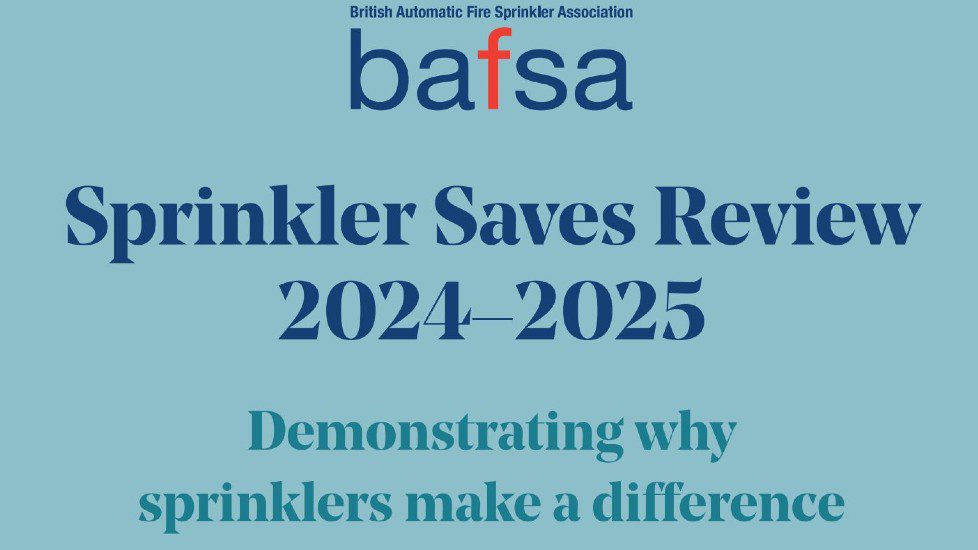“A firefighter in every room” – this is a strapline of BAFSA (the British Automatic Fire Sprinkler Association), our industry body.
As Phil Garrigan (Chair of the National Fire Chiefs Council, NFCC) writes in this year’s recently published ‘Sprinkler Saves Review’, “Put simply – sprinklers save lives and reduce injuries. They have been used for over a century and are consistently reliable, protect property, reduce the cost of repairs, and minimise the environmental impacts of fire…99% effective in extinguishing or controlling a fire”.
Periodically (using information from other sources, we can’t take all the credit!) we draw from some recent examples to highlight the benefits of fire sprinklers. Our monthly email goes out to thousands of contacts in the fire sprinkler and connected sectors; however, we like to think that anyone searching online for advice and evidence may come across one of our articles, and if it helps just one person make a decision which later saves their property – or indeed themselves – from serious damage or harm, then “job done”! We’re not trying to change the world but, after all, we are proud to work in a sector which aims to eliminate or reduce harm, so we and others will indeed continue to ‘bang on about it’!
BAFSA’s Sprinkler Saves project aims to raise awareness of the impact of fire, and how automatic water suppression systems can play a major part in damage mitigation – more information can be found here: www.bafsa.org.uk/sprinkler-saves
So, to highlight some examples…
Most people will remember the devastating car park fire in Liverpool which was probably longer ago than you thought… 31st December 2017, and destroyed over 1,000 vehicles! This was followed some years later (2023) by another car park fire at Luton Airport which destroyed over 1,300 vehicles. Miraculously, in neither case did anyone lose their life. So in May 2024, when fire sprinklers operated in Stowmarket to suppress a fire in an open-sided car park below a block of residential flats, it provided a perfect illustration of the benefits. No other vehicles caught alight, no-one was injured, and firefighters from Suffolk extinguished the fire completely – made much easier by the sprinkler activation, and with minimal damage.
There is no current legislation for sprinklers to be installed in student accommodation despite the higher risks that newly-found independence and a “lifestyle with a reduced level of caution when it comes to appreciating risk or identifying the importance of fire safety”. However, recent legislation has required sprinklers in all buildings over 11m, which does cover a growing number of city-centre student accommodation blocks which have been and are being built across the UK. There are a number of examples of sprinkler-contained fires in BAFSA’s update, including a bedroom fire caused by an incense candle, a kitchen fire caused by an air fryer (severe damage, but completely contained within the compartment itself).
A very recent example, from July 2025, is a south-Wales high-rise residential building where Bron Afon Community Housing Association took a decision in 2011 to retrofit sprinklers in some buildings under their control. Some 13 years later, fire crews were called to a 12-storey building where they found a chip pan fire in a kitchen o the first floor had been completely contained and extinguished by a single sidewall sprinkler head. There had been a minor evacuation and no injuries. There is a misconception that sprinklers cannot or should not be used for chip pan fires; however, this is a clear example of perfect effectiveness.
Finally, another recent example, where not automatic sprinklers but an external drencher system was used by Lancashire FRS (www.sprinklersaves.co.uk/saves/lancashire-industrial-manufacturing-drencher-sprinkler-activation/) to prevent an external plastics fire from spreading to the main building. The extreme heat of the external fire, as much as 700oC, was preventing any safe approach by the 50 firefighters on site. Activation of the drencher system outside the main building helped reduce temperatures and allow better access by the crew; otherwise, there could very easily have been further fires inside the building and consequently massive losses and danger to life.
For any further information, please contact BAFSA (www.bafsa.org.uk/contact-us) or ourselves Contact Us to see how we can help.

